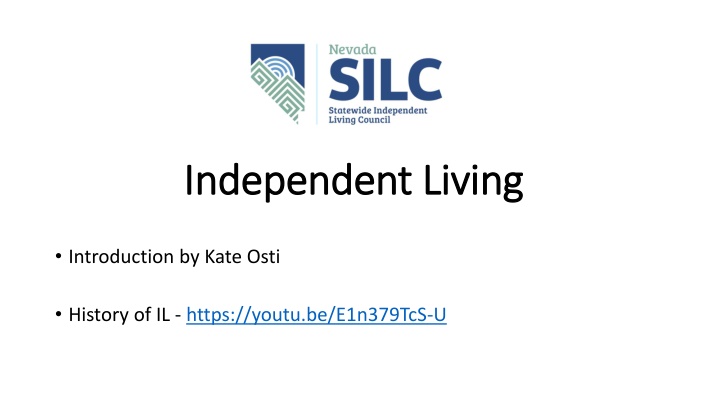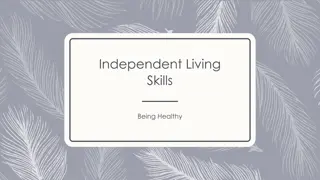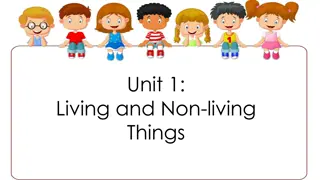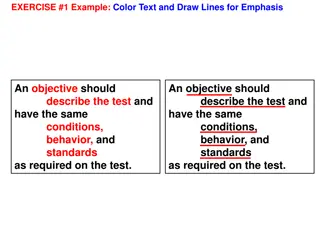
Independent Living
Learn about the Independent Living philosophy, the concept of self-determination, and the difference between the medical model and Independent Living. Explore how individuals with disabilities have the right to make their own choices and live independently.
Uploaded on | 0 Views
Download Presentation

Please find below an Image/Link to download the presentation.
The content on the website is provided AS IS for your information and personal use only. It may not be sold, licensed, or shared on other websites without obtaining consent from the author. If you encounter any issues during the download, it is possible that the publisher has removed the file from their server.
You are allowed to download the files provided on this website for personal or commercial use, subject to the condition that they are used lawfully. All files are the property of their respective owners.
The content on the website is provided AS IS for your information and personal use only. It may not be sold, licensed, or shared on other websites without obtaining consent from the author.
E N D
Presentation Transcript
Independent Living Independent Living Introduction by Kate Osti History of IL - https://youtu.be/E1n379TcS-U
The Independent Living Philosophy The Independent Living philosophy says that every person, regardless of disability, has the potential and the right to exercise individual self-determination.
What is Self-Determination? Self Determination refers to a characteristic of a person that leads them to make choices and decisions based on their own preferences and interests, to monitor and regulate their own actions and to be goal-oriented and self-directing.
Medical Model Vs. Independent Living The Independent Living philosophy is very different from the medical model and calls for a different way of perceiving and relating to people with disabilities. The problem has been that people with disabilities are often dependent on others to make decisions about their lives. Widespread discrimination toward people with disabilities is a significant issue. In the IL paradigm, disability is considered a natural part of the human experience. Independent living means controlling what is done in your life, and making your own decisions. The problem lies in the environmental, social and economic barriers that people face. The solutions are civil rights protections, removal of barriers, and strong advocacy efforts to make change happen. The desired outcome is a person who controls his or her own life, has opportunities comparable to other citizens, participates in the community as they wish, and who has economic security.
Medical Model Vs. Independent Living In the Independent Living movement Gerben DeJong developed the Independent Living Paradigm in the late 70 s. Saying in part that a shift was needed from the medical model to an Independent Living model. Starting with individual empowerment and responsibility for defining and meeting one's own needs. That people with disabilities were not the problem, no longer seen as broken, certainly not in need of repair. The problems were within society. There is a need for fixing society and not the person with a disability. Important decisions must be made by the person not the professional. What took place was that people began to view themselves as powerful and self- directed, not victims or objects of charity. It s important to understand and recognize that when saying medical model we are not just talking about medical folks. This can include family or professionals that are part of the services, organizations, and agencies that we come in contact with.
Medical Model Vs. Independent Living We need to be and are the experts on what we want and need. The phrase Nothing about us without us is more than a slogan. Nobody knows our issues better than we do. If we don t speak for ourselves, others will speak for us. And our priorities will not be at the forefront. While it is not always with bad intent, there can be an assumption for others to think they know what is best for us.
Centers for Independent Living: The five core services Information and referral IL skills training Peer counseling Individual and systems advocacy Services that facilitate transition from nursing homes and other institutions to the community, provide assistance to those at risk of entering institutions, and facilitate transition of youth to postsecondary life.
Nevada SILC Mission and Vision The mission of the Council is to advocate for the development of a network of programs, services and options designed to empower Nevadans with disabilities to live independently in the community. Our vision is to collaborate to create a community that values respect, equality and self-direction throughout the State.
Youth Action Council Youth Leader Cody Butler codybutler@adsd.nv.gov or visit https://www.nvsilc.com/get-involved/join- the-youth-group/
NV SILC Goals Goal 1: Improve Access to Independent Living Supports and Services. Goal 2: Improve Awareness of Independent Living Network and Philosophy. Goal 3: Improve the Effectiveness and Efficiency of the Independent Living Network.
Collaboration and Involvement The SILC s intentions are to become involved in advocating for legislature that supports independent living efforts across the State. Working together with our community to address the needs of individuals with disabilities is best practice. Join us in our efforts and make your voice heard!
Chair: Ace Patrick Vice Chair: Julie Weissman-Steinbaugh Voting Member: Renee Portnell Voting Member: Havander Davis Voting Member: DeeDee Foremaster Voting Member: Kate Osti Voting Member: Sabra McWhirter Voting Member: Raquel O Neil CIL Rep: Mary Evilsizer VR Rep: Victoria Essner Dept. of Ed. Rep: Jennifer Kane DSE Rep: Cheyenne Pasquale https://www.nvsilc.com/ nvsilc@adsd.nv.gov Dawn Lyons, Executive Director dlyons@adsd.nv.gov (702) 757-7990 Mailing Address: NV SILC P.O. Box 33386 Las Vegas, NV 89133
Presenters: Kate Osti SILC Member John Rosenlund AT/IL Program Director Sabra McWhirter SILC Member Dee Dee Foremaster SILC Member Dawn Lyons SILC Executive Director
References addressing a medical model: History of Independent Living Gina McDonald and Mike Oxford History of Independent Living | Independent Living Research Utilization (ilru.org) Get to the Core of It: Best Practices in CIL Core Services -- Systems Advocacy Stephanie Woodward Get to the Core of It: Best Practices in CIL Core Services -- Systems Advocacy (1.5 Hours) | Independent Living Research Utilization (ilru.org) IL History and Philosophy: Orientation for IL Staff Judith Holt, Cathy Chambless, Richard Petty, Darrell Lynn Jones, Marilyn Hammond, Donna Gleaves and Helen Roth IL History and Philosophy: Orientation for IL Staff | Independent Living Research Utilization (ilru.org)






















